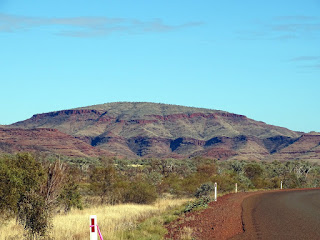We drove from Karijini NP towards Port Hedland, missing Millstream and the coast from Karratha north as the bitumen favoured this route.
The red earth of the Pilbara which stains everything it touches including our white, brown and black dog who is now a red, brown and black dog.
We stopped at another great rest stop along the way, the Albert Tognolini rest area 179 km NW of Newman and 17 km south of the Auski Roadhouse. We had also stayed here two nights ten years ago and we did the same again this time.
Andrew did the big walk up along the ridge above, same as he did last time. The view along the valley of this gorge is very lovely.
One of the many cliff faces which greet you along the road. The land formations in the Pilbara are all spectacular and beautiful. I think it was the Premier of WA, Mark McGowan, who advised his citizens in this time of Covid-19 and restrictions on overseas travel, to "Make the most of what you have" and what we have is an amazing state, with doors mostly open and always welcoming.
We arrived in Port Hedland on Friday with a number of tasks to fulfill. I needed a haircut and a replacement for my dead watch which proved nigh impossible to achieve until now. Tom Price, the biggest town until now, had a very limited range to choose from. Buying the Weekend Australian was not as easy as you would think. In many places the paper comes either a few days later or not at all. I was lucky enough to manage to get one on Sunday after a visit to the craft market which was held in the centre of town, the first market since the Covid-19 lockdown.
Port Hedland is not known for its beauty or as a tourist attraction. It is a working town, and best known for its massive resource industry, long trains, big ships hauling iron ore and salt piles. Its natural deep anchorage harbour has been widened and deepened over the years and is the site of the highest tonnage port in Australia. Other major resource activities supported by the town include the offshore natural gas fields, salt and manganese and livestock. Grazing of cattle and sheep was formerly a major revenue earner for the region but this has slowly declined.
The large salt mounds of Dampier Salt located between Port Hedland and South Hedland have almost become a tourist attraction in their own right.
The flat rocks along the beach near Pretty Pool inlet.
The Esplanade Hotel built in 1904. This Edwardian building is the most impressive building in the town.









No comments:
Post a Comment